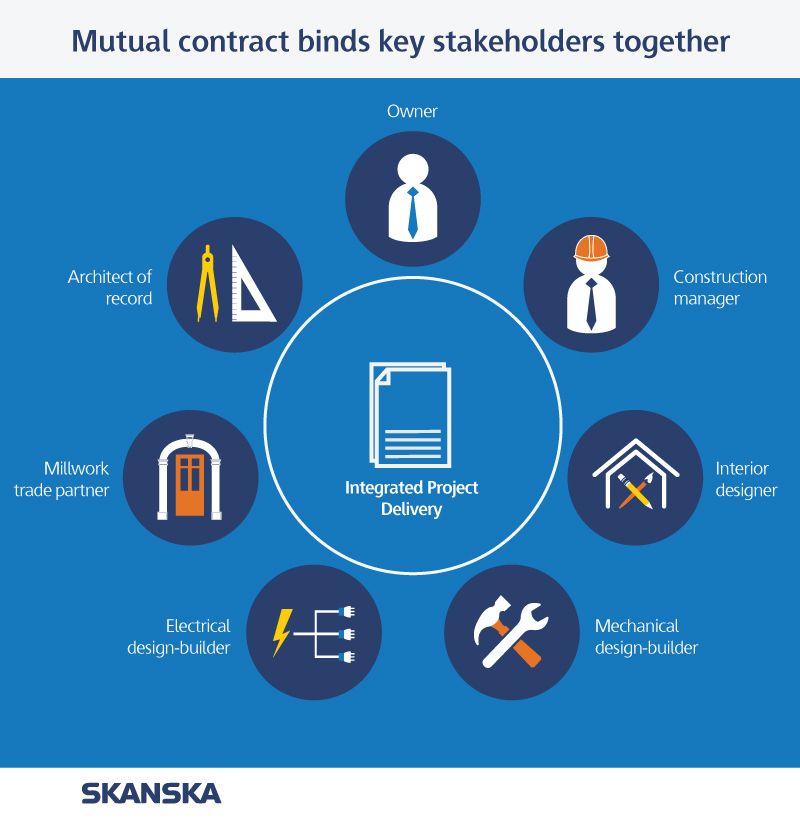Help us improve your experience. See content that is made for you!
See how IBM increased their efficiency by up to 30%!

Help us improve your experience. See content that is made for you!
See how IBM increased their efficiency by up to 30%!


“There’s no ‘I’ in team…
“….Be a team player.
….Take one for the team.”
Despite the overused and often annoying references to teamwork we’ve all heard a million times, we hate to sound like a broken record, but teamwork is actually vital to the success of construction projects. Think about it. You have an architect, owner, design team, contractors, subs, etc. If one of those members falls short, the whole project can crumble faster than you can say, “teamwork makes the dream work.” In fact, in companies in general, 97% of employees and executives believe lack of alignment within a team impacts the outcome of a task or project. In construction, how projects deliver determines how teams work together. Methods vary from Design-Bid-Build, Design-Build, Construction Management at Risk and Multi-Prime, but none of these fully address the collaboration issues that can occur in construction teams except Integrated Project Delivery (IPD).
Before we get more into what IPD is, take a moment to think about all the issues you’ve seen on a jobsite. The most common issues that disrupt a project have nothing to do with weather, equipment, or obstacles. Instead, antagonistic, adversarial relationships, unclear expectations and confusion about roles and responsibilities wreak havoc on a team’s ability to collaborate. Rework, disputes, and other issues often stem from problems with communication and project management–and the larger the project, the bigger the problems can be.
While the challenges above don’t plague every project, they impact many of them; causing unnecessary delays, higher than anticipated costs and a less than ideal working environment for all concerned. In construction, how projects are delivered really matters and integrated project delivery is becoming a compelling solution for companies looking to improve communication and collaboration. Therefore, implementing an innovative approach to project delivery can help you avoid these issues entirely and help ensure you have a harmonious team – and a successful project.
Below, we’ll discuss the basics of integrated project delivery, as well as the benefits of adopting the approach for construction teams.
Integrated project delivery (IPD) allows you to create mini-organizations that last for the length of a single project to power that project to success. When you bypass the conventional and often flawed method of running a project, you can streamline it, ensure that every member of the team is empowered and has a clearly defined role and even cut your costs.

The main goal of Integrated Project Delivery is to create a team that can work together well enough to power the project for success. This team works as a single organization for the length of the project and may include members from a variety of disciplines, including:
Working together, this group will pool their knowledge and abilities and match team members with the best possible roles. Everyone, including the contractor, owner and architect/design team operates under the same contract and works with the same goals in mind. When success is defined for the team, instead of for individual players or components, working together effectively is incentivized and the infighting typical of many construction zones is minimized or eliminated.
In a recent episode of our Digital Builder podcast, Ariana Alvear, Senior Production Manager at The Boldt Company, shared her experience working on IPD projects. “IPD goes beyond a contract because it’s a type of contract. It’s a culture that you get invited to. It’s inviting everybody to think about what’s better for the project instead of only focusing on your scope of work,” she says.
And the owner is a crucial ingredient to IPD's success. “The owner, in my experience, is a very key component. If they’re in, that makes a difference. And it’s not about only saying, ‘I’m going to do IPD, and I’m going to build a Lean project.’ You need to actually act on it and behave like it," she explains. "The owner has to be involved in all these meetings and set the pace. They need to set the example.”
Integrated Project Delivery operates differently than conventional project management methods but often results in more productivity and efficiency and reduced risk and losses. The focus shifts from “how does my company succeed on this project” to “how do we ALL succeed on this project”.
Integrated Project Delivery differs from the conventional methods in several ways, including the way the team is assembled and the actual phasing and execution of the project. Building a team that is capable and that has the ability to work harmoniously together is the best way to ensure success—to build that team, the following steps are recommended:
In order for IPD to truly work and hold team members accountable, a Multiparty Agreement (MPA) is needed as a primary contractual agreement. MPA allows all primary participants in a project to be covered and included in a single contract. This document outlines the following details for each participant:

This document officially establishes a smaller team within an organization that is dedicated to a single project. The contract makes it easy to fully define roles and hierarchy in a specific location, so everyone understands not only their own responsibilities but what their role is on the team. It’s especially helpful when questions arise if clarification is needed or to settle disputes. By detailing all of the important components in advance, you can avoid having the project disrupted and slowed later.
Since compensation is often dependent upon success, MPAs require both trust and an effective, efficient working relationship. In general, this type of contract is more team-friendly. For instance, all members need to be onboard and working together to fulfill the group goals. An MPA can solidify a team’s relationship and help make things “official” and is often the first step to a successful project.
Recruiting team members with a history of success and experience with collaborative efforts can help drive the entire group to success. While the specific text and scope of an MPA can vary, they generally:
What can Integrated Project Delivery do for your project? Every time you launch and complete a new project, your employees become more adept at collaboration, better at working as a team and more excited about the prospect of working on another project of this type. “It’s true collaboration. And because you’re constantly collaborating, constantly checking on how you’re doing, you can forecast how you’re going to finish,” says Alvear.
Some of the benefits of this dynamic and precise form of management include:
Keep in mind, that when IPD is combined with Lean construction principles, these benefits have the potential to increase tenfold, especially from the reduction of waste and inefficiencies.
We’ll say it again, an aligned team is critical for a successful project and essential for IPD. The better your team works together as a collaborative group with strong ties, the more effective the system will be. Both compatibility and communication skills are key characteristics that are necessary for IPD team members. Teamwork doesn’t stop with the assembly or selection of members; the sense of actually being a working team should be fostered whenever possible. Setting up new workspace when available, creating a “special ops” feeling and scheduling regular meetings, conferences and opportunities to collect and interact in person are essential to success. Your team is at the heart of your integrated project–and if that team does not function effectively, you won’t get the results you want. Focus on who you want on the team and in setting reasonable, achievable expectations, to maximize integrated project delivery.
Investing in your relationships within your own team and with the contractors you need can only enhance your project efforts. Appreciating the role each plays in a successful project and ensuring that every member gets an equal voice can drastically improve your success rate.
Filling your team with professionals who not only are capable at their own roles, but able to respect, listen to and learn from others can also ensure your new organization runs as efficiently as it possibly can.
For integrated project delivery to be successful, every member of your team needs to not only understand the roles and goals that are being assigned to them but also provide clear and reasonable timelines and promises. By refusing to pressure team members to accept a given timeline and working instead with reasonable goals and expectations, you can avoid problems down the road.
While your focus will be on creating a successful project, having contingency plans can help you identify risk and immediately take action if something goes wrong. Your contingency plans should cover what happens in the event of an unexpected activity like extreme weather or emergency, the steps you’ll take and who will be responsible for assessing and addressing problems. Clearly defining this as your team comes together avoids unpleasant surprises and ensures everyone understands their stake, risk and role at the very beginning.
While your team needs experienced talent, don’t overlook the power of personality and the ability to get along with others. When you find someone with the perfect combination of ability, experience and personality – keep them. Retaining your key team members and then deploying them to important projects can considerably lower your stress levels and boost your success.
In the majority of projects, technology facilitates and improves the collaboration needed for successful integrated project delivery. Since most projects involve complex relationships with a variety of stakeholders, the programs and tools used for other businesses simply won’t work. Large, cumbersome attachments and inelegant, slow means of communication make typical business solutions useless for IPD.
Instead, using collaborative tools that not only support construction’s needs but that are specifically designed for the industry, ensures success with integrated project delivery. When all members of the team can communicate, collaborate and contribute with real-time information and access, many of the traditional problems associated with construction project management are drastically reduced.
Using collaborative tools to enhance and overcome IT and communications challenges improves both efficiency and productivity. Data and documentation flow are improved, and workers on-site are better able to convey needs and concerns to those in the office in real time. By facilitating this communication, construction brands can improve their customer experience and increase revenues and profits.
Construction is already complicated and needs tight teams to achieve even the most basic budget and schedule goals. By making integration and synergy a part of projects from the start with IPD, the more likely construction will go smoothly. In addition, you’ll build better and long-term relationships with your team, as well as be able to turn more profits over time. Now’s the time to commit to teamwork for construction delivery. Get started and explore how you can bring integrated project delivery to your future projects.
Watch more:

May we collect and use your data?
Learn more about the Third Party Services we use and our Privacy Statement.May we collect and use your data to tailor your experience?
Explore the benefits of a customized experience by managing your privacy settings for this site or visit our Privacy Statement to learn more about your options.